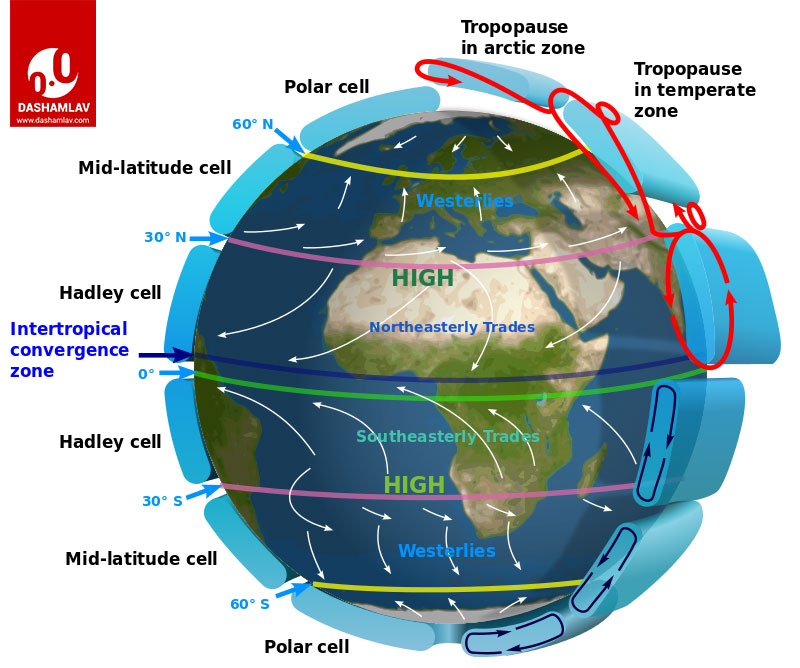Atmospheric Circulation is the movement patterns of the planetary winds. In the case of our planet earth, the general atmospheric circulation is the large-scale movement of air surrounding the earth. Together with the oceanic circulation, the atmospheric circulation is the agent that redistributes the thermal energy on earth. Although the circulation varies from year to year, the large-scale pattern of the circulation remains fairly constant.
Factors Affecting the Pattern of the General Circulation of the Atmosphere
Basically, the movement of air is caused by heat differentiation i.e. the uneven solar radiation received by different parts of the earth. But, there are various other factors that affect the pattern of the general circulation of the atmosphere.
Following are the factors affecting the movement patterns of the planetary winds:
- Differential atmospheric heating due to latitudinal variations
- The emergence of the pressure belts
- Movement of the pressure belts following the apparent path of the sun
- Distribution of continents and oceans
- Rotation of the earth
Understanding How Does Air Circulates
- As the air above the equator heats up from the solar radiation, it rises up creating low pressure and causing rainfall
- When the heated air touches the edge of the atmosphere, it cannot go any further hence it travels to the north and south of the equator
- The air, on reaching 30 degrees north and south of the equator, becomes colder and denser. This cold and dense air falls creating high pressure and dry condition at 30 degrees north and south. This way large cells of air are formed.
- Similarly, air traveling from 30 degrees again rises around 60 degrees and descends at 90 degrees north and south latitudes.
In this way, three distinct cells of air are formed in each hemisphere. In these cells, air circulates through the entire depth of the troposphere.

Hadley Cells
Hadley cells are the air cells of the tropics. The air gets heated due to insolation at the equator. As the warm air rises up, it separates and starts moving towards the north and south poles at a height of about 10-15 kms above the earth’s surface. This air cools and sinks towards the ground at 30 degrees north and south latitudes.
As the air descends, it becomes warmer and drier creating an area of fewer clouds and lower rainfall. The air then flows towards the equator as trade winds near the earth’s surface thus creating a circulation called Hadley cells in the tropical region.
The Hadley cells are low-altitude overturning circulation that creates trade winds, tropical rain belts and hurricanes, subtropical deserts and jet streams. They are responsible for the formation of many of the world’s largest and driest deserts, including the great Sahara deserts. As the air circulates back to the equator, it forms dry winds that get heated as they move towards the equator. The dry winds dissipate existing clouds thus allowing more sunlight to reach the earth’s surface thus creating a proper atmosphere for the formation of a desert.
Ferrel Cells (Mid-latitude Cells)
The air cells circulating between the 30 degree and 60 degrees latitudes in both hemispheres are called the Ferrel Cells. In the mid-latitudes, the air flows poleward and eastward near the surface of the earth and equatorward and westward at the higher altitudes. The circulation of air in the Ferrel cell is the reverse of the Hadley cell.
The winds blowing towards the higher latitudes pick moisture from the oceans and they meet cold air that has drifted from the poles at around 60 degrees latitudes. The Meeting of these two air masses creates an area of unstable weather conditions associated with mid-latitude depression.
Ferrel cells, unlike the two other cells, are thermally indirect circulation in which the warmer air descends and the cooler air rises. This is so because it is driven by the motions of the cells on either side i.e. the Hadley cells and the Polar cells.
Polar Cells
The air cells circulating between 60 degrees latitudes and 90 degrees latitudes is termed as the polar cells. The cold dense air subsides near the poles and blows towards middle latitudes as the polar easterlies. These are the smallest and weakest among the three cells. Just like the Hadley cells, the polar cells are thermally direct. A high pressure, called the polar high, is created at the poles as cool air sinks towards the ground. The low pressure created at 60 degrees latitudes where the cold polar air mixes with the warm tropical air and rises upwards is called sub-polar low. The boundary between the cold and warm air is called the polar front.
Frequently Asked Questions
Q. What causes atmospheric circulation?
A. The circulation of the wind or the atmospheric circulation is driven by the incoming solar energy and the rotation of the earth.
Q. What is a tri-cellular model of atmospheric circulation?
A. The air circulation model consisting of the Hadley, Ferrel and Polar cells is called the tri-cellular model of atmospheric circulation.
Q. What is thermally direct circulation?
A. A circulation in which relatively warmer air rises and relatively colder air sinks are called the thermally direct circulation. Thermally indirect circulation is just the reverse.
Q. What are mid-latitude depressions?
A. Mid-latitude depressions also referred to as mid-latitude cyclones are the area of low pressure lying between the 30 degrees and 60 degrees latitudes. They are formed when warm westerlies from the sub-tropics meet the cold air from the Polar Regions.
Use the citation below to add this article to your bibliography
"Atmospheric Circulation: Hadley, Ferrel and Polar Cells." Dashamlav.com. Web. 27 July 2024. <https://dashamlav.com/atmospheric-circulation-hadley-ferrel-polar-cells/>
Dashamlav.com, "Atmospheric Circulation: Hadley, Ferrel and Polar Cells." Accessed 27 July 2024. https://dashamlav.com/atmospheric-circulation-hadley-ferrel-polar-cells/
"Atmospheric Circulation: Hadley, Ferrel and Polar Cells." (n.d.). Dashamlav.com. Retrieved 27 July 2024 from https://dashamlav.com/atmospheric-circulation-hadley-ferrel-polar-cells/
